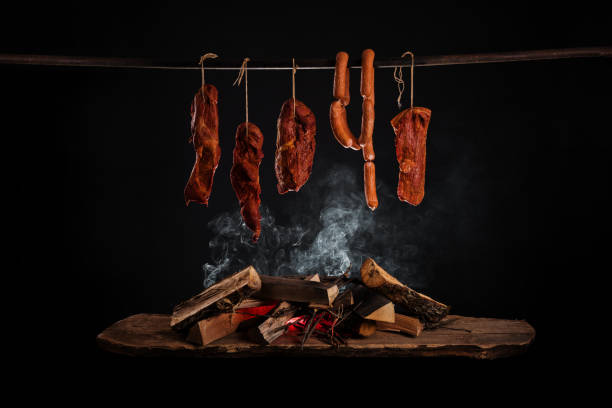
How to Become a Pro Smoker: A Beginner's Guide
Barbecue season is right around the corner and what better way to show off your grilling skills than to smoke some delicious meats? Smoking not only adds flavor to meats, it also tenderizes and preserves the ingredients. If you're a beginner to smoking, follow this guide to become a master of the craft!
To begin, make sure you have a great quality smoker or grill. If you're new to smoking, it is recommended that you start with charcoal or wood chips to get a feel for the craft. Once you have your smoker or grill, you can choose the meat you'd like to smoke. Try something classic like pork, beef, or fish or something more adventurous like game meats. Aim for cuts that are between 1-2 inches thick as this will create a juicy, tender piece of meat.
When smoking your meat, make sure that you keep the smoker at a low, consistent temperature. If you're using a charcoal grill, this means having a good coal base and regulating the air flow with a chimney starter. For a gas grill, set the temperature to low and use wood chips to create a smoky flavor. The type of wood chips you choose will determine the flavor of the meat. A few classic options include hickory, apple and cherry.
To ensure that your meat is cooked through and juicy, use a meat thermometer to measure the internal temperature of your meat. The USDA recommends that red meats be cooked to at least 145 degrees Fahrenheit and poultry to 165 degrees Fahrenheit. Once your meat is cooked to the desired temperature, let it rest for 15 minutes before slicing. This will let the juices redistribute, giving you a juicy, flavorful piece of meat.
Smoking meats is an art, but anyone can become a master of the craft with some practice. Follow this guide and you'll be producing delicious smoked meats in no time!
Choose Your Wood
The type of wood you choose to use is essential in creating the right flavor in your finished product. Whether you use hickory, mesquite, oak, or any other type of wood, the wood will play a large role in the final taste of your smoked meat. Do some research on the type of wood that pairs best with the type of meat youâre smoking and the flavor youâre trying to achieve.
It is important to pay attention to the type of wood you choose for smoking your meat as it can drastically change the flavor. In general, hickory is a popular choice for pork and chicken, mesquite for beef and big game, and oak is a more all-purpose wood. However, there are many other types of wood available, such as maple, cherry, apple, and pecan, that can be used to achieve a unique flavor. The size of the pieces of wood are also important; larger chunks and chips will burn slower and last longer while smaller chunks and chips will burn faster.
It is best to experiment with different types of wood and sizes to personalize the flavor of the smoked meat. Try using combinations of different woods and chunks of different sizes, such as a few larger chunks of hickory and some smaller chunks of mesquite, to create a unique flavor. It is also important to avoid using green wood as this will produce a bitter and acrid taste.
When you have a good understanding of the type of wood and size of chunks you prefer, buy enough to last you so that you don't have to keep buying it. Storing it in a dry place will help to keep it in good condition. When it's time to smoke your meat, remember to let the wood burn down completely before adding your food to the smoker; the fire needs to be red hot and with no visible smoke, otherwise it will affect the flavor of your meat.
Pick Your Meat
The meat you choose to smoke will also factor into the flavor. For example, if you’re smoking a steak, you’ll want to select a cut of steak with the right amount of marbling or fat content to pick up the flavors of the smoke. If you’re smoking chicken, you’ll want to use a chicken that’s on the smaller side. Smaller chickens will cook faster and will better absorb the flavor of the smoke.
When smoking larger pieces of meat, like brisket or pork shoulder, you may want to choose a cut with a good amount of fat to ensure the meat stays moist while smoking. While adding flavor, the fat also helps to keep the meat from drying out. Additionally, feel free to add your own personal favorite seasonings as you prepare your meat for smoking. This will further enhance the flavor of the smoke and give you a unique taste all your own. No matter what type of meat you choose to smoke, it’s important to pay close attention to the cooking temperature and time. The temperature of the smoker should remain consistent and the time you smoke the meat will depend on what type of cut it is, as well as the size of the cut.
Using the proper tools for smoking meat is also incredibly important. This includes a thermometer to make sure the smoker is at the right temperature, as well as a timer or probe thermometer to let you know when your meat is cooked through. It’s also a good idea to use heat-resistant gloves and utensils while preparing your meat. Finally, it’s important to give your cooked meat the proper resting time once it’s done cooking. This will ensure the flavor and moisture are locked in, giving you a delicious meal that’s been smoked to perfection.
Prepare Your Smoker
Before you begin to smoke, youâll need to properly prepare your smoker. Make sure to inspect the smoker and clean it thoroughly. Youâll want to make sure thereâs no rust or residue that could affect the taste of the meat. Once youâve cleaned the smoker, itâs time to add the wood. Depending on the type of smoker you have, you may have to add wood chips and charcoal to achieve the desired smoke intensity.
Once you've added the wood chips and charcoal, it's time to set up the smoker. Make sure that all the vents are open to let the smoke out. You'll also want to make sure the lid of the smoker is closed so that the smoke can be contained within the chamber. Additionally, if your smoker has a water pan, make sure to fill it with water to maintain the desired temperature and humidity.
Finally, it's time to light the smoker. Depending on the type of smoker you have, you may need to light the charcoal and wood chips directly, or you may need to light a wood-burning stove to get the smoker going. Once you've lit the smoker, allow it to warm up for 30 minutes or so before you start adding the meat. Check the temperature gauge periodically to make sure it's in the right range. Once the smoker is ready, throw in the meat!
Start the Smoke
Once everything is in place, it’s time to start the smoking process. Place the meat on the grates and close the lid. You’ll want to keep a close eye on the temperature throughout the smoking process. If the temperature rises too high, the meat can overcook and become dry. Also, if the temperature drops too low, the meat may not absorb the flavor of the smoke. Aim for a consistent temperature between 225-250°F.
Set the vents to achieve and maintain the desired temperature. Most smokers will have vents on the top and/or bottom of the smoker. This will allow you to regulate the temperature of the smoker by adjusting the flow of oxygen. The vents should be set to achieve a consistent temperature of 225-250°F throughout the smoking process.
You may need to adjust the vents periodically as you monitor the temperature inside the smoker. If the temperature is too low, you should open the vents slightly to allow more oxygen to flow into the smoker and raise the temperature. Conversely, if the temperature is too high, you should close the vents slightly to restrict the oxygen flow and lower the temperature.
It can also help to keep a water pan in the smoker. The water pan serves to help regulate the temperature as well as add moisture to the air. This moisture will help the meat stay juicy throughout the smoking process. Maintaining the ideal temperature and keeping the air moist will help ensure the meat absorbs the flavor of the smoke and cooks evenly.
Enjoy the Fruits of Your Labor
Once the meat has reached the desired internal temperature, it's time to enjoy the fruits of your labor. The smoky flavor and tender texture of the meat will be sure to impress your friends and family. With a little practice and research, you'll be smoking like a pro in no time.
Slice the meat, and the aroma of the smoky flavors will make your mouth water. Take the first bite, and you'll immediately taste the difference between the juicy, flavorful meat that was smoked, rather than grilled or roasted. Enjoy the meat on its own, or use it to make sandwiches, tacos, or any other recipe you desire.
If your results are as good as they should be, you can begin to experiment further with different types of wood chips, different temperatures, and different times. Smoker cooking is an art form, and the more you practice, the better you'll become.
The benefits of smoker cooking are endless. Not only is the food delicious, but the entire process is quite relaxing. You can set up the smoker, enjoy a cold beer, and kick back while your meat takes care of itself.
Smoker cooking may take some trial and error to get comfortable with, but with practice, you'll be able to perfect your barbecue. So, go ahead and give it a try. Before you know it, you'll be the talk of your summer barbecue.
